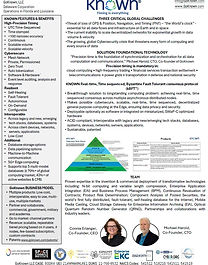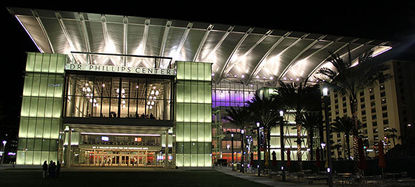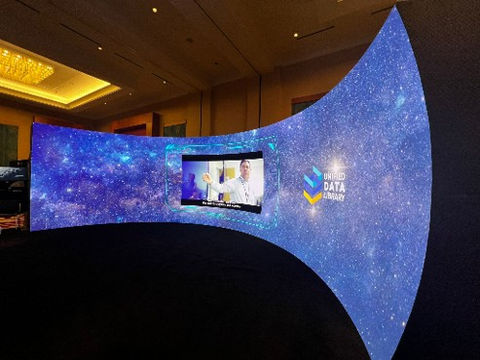
June 27, 2025
5:00 pm - 6:00 pm
Dr. Phillips Center
Orlando, Florida
Space
Planetary
Synergy
Pinnacle
Panel
Welcome Aboard Spaceship Earth
You have arrived at the prime-prize-pinnacle of our C-Suite summit. For two days, we have gathered the who's who in digital twins, from powerhouse brands with critical requirements to the best-in-class providers delivering those solutions. Now, this all culminates in a captivating-crescendo, our one and only grand finale.
Not merely just another panel; enjoy this live, unscripted convergence of the mightiest minds shaping our future, and a moment that will not be repeated. To witness where requirements and the resulting industry solutions are all truly heading—and have to have voice in that direction—your place is here, now.
Logistics
Friday
June 27, 2025
5:00 pm - 6:00 pm
Space Panel
Main Summit
Wednesday
June 25, 2025
6:00 pm - 10:00 pm
Thursday
June 26, 2025
8:00 am - 11:00 pm
Friday
June 27, 2025
8:00 am - 10:00 pm
Expert Panelist Luminaries
Founder
& Director of
Global Partnerships
Global Ecosystem Builder
& Community Leader


SPACE
IGNITER
Mike
Vinje
Small Business
Technology
Advisor

Transferer of
Top Technology Transfer

We are honored to host personnel from the United States Space Force. Please note they are participating in their own individual and private capacities. The views and opinions expressed by these individuals are their own and do not represent an official endorsement by, nor do they necessarily reflect the official policy or position of, the United. States Space Force, the Department of Defense, or the United States Government.
Disclaimer
Exhibit Hall Exhibit



Silo-Smashing Synergistic Space Super
Sequence
✓ Serialize
✓ Stabilize
✓ Socialize
✓ Synergize
✓ Strategize
✓ Synthesize
✓ Synchronize
✓ Standardize
Color Guard
Our Greatest Gratitude
for
Presentation of Colors
&
National Anthem
by


Cadet Color Guard
Cadet Alyssa Mahoney
Cadet Veruschka Nunez
Cadet Michelle Herrera
Cadet Julia Vasquez
Singer
Cadet Angel Rodriguez
Advisor
Lt Col (ret) Rick Proctor
Senior Aerospace Science Instructor
U.S. Air Force JROTC
Dr. Phillips High School
Silo-Smashing Synergistic Space Super
Sectors
 |  |  |
|---|---|---|
 |  |  |
 |  |  |
 |  |  |
 |  |  |
 |  |  |
 |
Panel Description
Summary
Our Final Digital Frontier:
A 'Universe'al Twin for the Space Super-Sector
A Plain Panel?
Sorry Dave - I’m Afraid I Can’t Do That
Join Your Pre-Launch Mission Brief Instead
For two defining days, we have explored the dynamic digital twins transforming aviation, transportation, and our interconnected cities. Now, we unite these terrestrial applications to take on the one frontier that encompasses them all. This grand finale explores how the ultimate synergistic super-sector, that we call Space, will challenge our technology, propelling it from discrete, isolated models to a truly interconnected, planetary scale. To unlock this future, we will journey back to our roots, revealing how a concept born from the Apollo program has now come full circle to give ultimate purpose to everything we have discussed.
This is a mission to heal a fragmenting world, built on the foundational belief that by building a unified model of our Earth, we also forge the pathway to a more unified human society. We will explore how the Overview Effect—that profound cognitive shift in perspective only possible from space—can finally break the damaging cycles of hyper-segmented thinking. At its heart is a fascinating methodology, a “Looking-Glass Logic” that requires us to build a perfect mirror for our mirror to create a trusted, true systems-of-systems model of Earth.
Such a monumental undertaking demands more than titanic technology; it demands a new collaborating coalition of talent from every disparate discipline. Ultimately, this journey is about humanity learning to see itself as a whole again, creating a future that proves with absolute conviction:
There's a Place, In Space, for Every Face.
Panel Description
Detail
Our Final Digital Frontier:
A 'Universe'al Twin for the Space Super-Sector
A Plain Panel?
Sorry Dave - I’m Afraid I Can’t Do That
Join Your Pre-Launch Mission Brief Instead
01 - Not a Panel - A Mission
Every session, every discussion, and every connection has targeted this moment. Strap in for the grand finale. Enjoy the culminating, pinnacle session of our entire conference. We have journeyed through the digital twins transforming manufacturing, infrastructure, and healthcare on Earth. Now, we prepare for the ultimate leap into the Synergistic Synchronizing Super-Sector that is Space.
02 - A Return to Our Roots
To truly leap forward, we must first return to our roots. We will go back to the very program where the concept of the digital twin was born, harnessing its original spirit to tackle our greatest challenge yet. This entire endeavor is driven by a foundational belief: that by building a truly unified model of our Earth, we also forge the pathway to a more unified human society.
03 - Our Origin Story: The Apollo Program
Ironically, the entire concept of a digital twin began in the stars. During the Apollo missions, NASA pioneered the use of high-fidelity, earth-bound simulators that mirrored their operational spacecraft—the first true "digital twins." When disaster struck Apollo 13, it was this mirrored system on the ground that allowed engineers to diagnose lethal problems, test daring solutions in a safe virtual space, and guide the astronauts through impossible repairs. This technology didn’t just make the impossible possible; it saved lives, turning a potential tragedy into humanity’s most successful failure and proving the profound power of a mirrored reality.
04 - Today's Ultimate Frontier
Today, that same foundational concept is pushed to its absolute limits. Space is not just another industry; it is the ultimate testbed, proving ground, and operational theatre for our most advanced ideas. This multi-sector, multi-domain, multi-discipline, and multi-jurisdictional frontier demands the most multi-talented talent to solve its multi-faceted, multi-vector challenges.
05 - Breaking the Cycles of a Fractured World
Consider yourself a key crewmember. Your insights and questions will fuel the conversation as we explore the digital nervous systems required for humanity's future in the cosmos. For too long, Earth's greatest problems have been caused by the hyper-segmentation and over-specialization we default to: We fix a human habitat problem, which causes a transportation problem, which results in a watershed problem, which then creates yet another transportation problem. It's time to stop making circular problems more circular.
06 - The Overview Effect: A New Planetary Consciousness
The solution requires a new perspective—one that can only be achieved from a distance. In this, we are guided by the brilliant work of Frank White, who first coined the term for this profound cognitive shift: The Overview Effect. Frank’s decades of research have shown how viewing the Earth from space—a beautiful, fragile, borderless whole—irrevocably transforms an astronaut’s consciousness. We must go off-Earth not just to see our world, but to finally comprehend it.
07 - The Looking-Glass Logic
From that vantage point, we can apply a true systems approach to finally see our beautiful Mother Planet Earth as the incredible, inter-everything planet she is. To achieve this, we must embrace a fascinating and profound methodology we call the Looking-Glass Logic. Referencing both a new perspective and a legendary aerospace program, this logic dictates that we must first build a perfect mirror for our mirror. This means meticulously twinning our space-based assets themselves, for only a perfected instrument can create a perfect reflection. It is the ultimate recursion—twinning the tools to truly twin the world.
08 - A Call to Every Sector
From the intricate logistics of Space Ports, to the dynamic sub-systems of Space Ships, the life support of Space Stations, and the foundational infrastructure of Space Bases, you will all see clearly why we must insist:
There's a Place, in Space, for Every Sector's Face.
09 - A Call to Every Face
But this mission's scope is more profound than uniting sectors alone. Just as our digital twin must embrace every interconnected system of our planet to be whole, our human endeavor to build it must embrace every discipline and passion to succeed. This is how we create true inspirational ignition, showing kids, college students, and young professionals that their unique talents—in art, ethics, communications, and strategy, alongside science and engineering—are not just welcome, but essential. And so we declare with equal conviction:
There's a Place, in Space, for Every Face.
10 - Your Voice is the Rocket Fuel
To tackle a frontier this vast, we must ditch the script. Forget what you know about conference sessions. This is a live, fully-interactive mission control delivered pre-launch crew briefing, powered entirely by the rocket-fuel of the questions that you, our amazing attending guests, ask.
11 - The Final Word: A New Vision for Humanity
This is the crescendo: a dynamic, collective conversation designed to unite every concept from our time together. Join us as we, the crewmembers of Spaceship Earth, champion the charting of the course for our most ambitious digital twin ever conceived. Ultimately, this journey isn't just about data, technology, or even space itself. It's about humanity learning to see itself as a whole for the very first time.
12 - The Twin Endings
In 3, 2, 1...strap in and prepare for a balance-bolstering, brain-building, bridge-boosting blast-off!
Let's explore the final digital frontier, together.
Brilliance born in the stars returns full circle to save our beloved Earth,
as does all space innovation & exploration.
For humanity's ultimate challenge, 'twinning' is winning.
Hawai'i: Petite Planet

The Mandate for a Proving Ground
Attempting to build a comprehensive digital twin of the entire Earth, or of another world like the Moon or Mars, without a preliminary case study would be an exercise, and an execution, in pure theory, destined for failure. Our Mother planet's interconnected systems present as infinitely too complex. To succeed, we must first develop and validate the methodology on a smaller and bounded, yet highly complex and representative, subset of the whole. We need a proving ground: a known, closed-loop environment where we can test our models, refine our sensor networks, and prove the "Looking-Glass Logic" before scaling up to a full planetary level. This initial deployment must be a microcosm of Earth, containing the diversity, challenges, opportunities, and even richness of the larger system.
Fortunately, the perfect natural laboratory exists. This leads us, naturally and logically, to the Hawaiian Islands:
Hawaiʻi: The Perfect Planetary Microcosm
For five core easons, Hawaiʻi stands alone as an almost perfectly designed ecosystem to serve as the world's first true "systems-of-systems" digital twin:
1. Geographic Isolation: A Perfect Closed-Loop Terrarium
• The World's Most Isolated Archipelago: Located over 2,000 miles from the nearest continent, the Hawaiian Islands are a naturally bounded and contained system. This extreme isolation minimizes external variables, making it far easier to model inputs, outputs, and internal feedback loops—the essential components of a digital twin. It is a true "ship in a bottle," allowing for controlled study of resource management and energy flow.
• A Testbed for Self-Sufficiency: Because of its reliance on imports, Hawaiʻi provides a critical environment for testing and modeling sustainability and circular economies. A digital twin could simulate the impacts of supply chain disruptions and model pathways to greater food and energy independence, providing invaluable lessons for other isolated communities and, ultimately, for "Spaceship Earth."
2. Social Fabric: A Model for Community and Collaboration
• The Aloha Spirit as a Social Framework: More than just a greeting, the Aloha Spirit is a codified law in Hawaiʻi representing a principle of mutual regard and affection. It fosters a powerful sense of community, interconnectedness, and collective responsibility ("kuleana") that is essential for the societal unification a digital twin aims to support. A digital twin of Hawaiʻi wouldn't just model resources; it would model a society built on a foundation of collaboration.
• A Diverse, Interconnected Population: As one of the most racially and ethnically diverse places in the world, Hawaiʻi serves as an invaluable living model of a pluralistic society. Modeling the social dynamics, resource needs, and cultural interactions of this "melting pot" provides an invaluable template for understanding the complex human systems of the entire planet.
3. Ecological Diversity: A Microcosm of the Planet
• Nearly Every Climate Zone on Earth: From the tropical rainforests of Hilo and the alpine deserts atop Mauna Kea to the sun-drenched beaches of Kaua'i and the volcanic landscapes of Kīlauea, the Hawaiian Islands contain nearly all of the world's climate zones in a compact area. This "planet in miniature" allows a digital twin to be trained and validated across an incredible diversity of environmental conditions simultaneously.
• Unique and Fragile Biodiversity: The isolation of Hawaiʻi led to the evolution of thousands of endemic species found nowhere else on Earth. This makes for a crucial laboratory for modeling fragile ecosystems, the impacts of invasive species, and the effectiveness of conservation strategies.
4. Academic and Research Powerhouse: The University of Hawaiʻi System
• The University of Hawaiʻi at Mānoa: A Global Leader: At the heart of the state's research capacity is the University of Hawaiʻi at Mānoa, a Carnegie R1 research university (the highest designation). It is world-renowned for its programs in oceanography, earth sciences, astronomy, and Pacific Island studies. Its School of Ocean and Earth Science and Technology (SOEST) and the Hawaiʻi Institute of Geophysics and Planetology are premier institutions, providing the world-class talent and data streams necessary to build and manage a planetary digital twin.
• A Hub of Excellence: Beyond UH Mānoa, the broader UH system and other institutions like Hawaiʻi Pacific University contribute to a powerful intellectual ecosystem. The state is a hub for research in marine biology, volcanology, and renewable energy, creating a data-rich environment perfect for this ambitious undertaking.
5. Advanced Scientific Infrastructure & Cultural Heritage
• A Window to the Cosmos and the Atmosphere: The summits of Mauna Kea and Mauna Loa are home to some of the world's most important astronomical and atmospheric observatories, providing a constant stream of high-quality data.
• The Ahupuaʻa System: Ancient Hawaiian society was organized around the ahupuaʻa, a sophisticated, holistic land management system running from the mountains to the sea. This traditional ecological knowledge provides a deep, time-tested cultural framework for the modern, technological "systems-of-systems" approach.
Conclusion: The Ideal Proving Ground
In summary, Hawaiʻi offers not merely an amazing choice to deploy the first comprehensive ecosystem digital twin; this “planet in miniature” is the perfect choice. Its physical isolation, immense ecological and social diversity, and world-class research institutions create a contained, representative, and data-rich environment. By first twinning this planetary microcosm, we can develop the tools, prove the "Looking-Glass Logic," and build the foundational model necessary to finally understand the Earth as a whole, fulfilling the promise of the Overview Effect, and the success of Digital Twins at a planetary scale.

Plug and Play

We have offices in over 70 cities and with over 125 accelerators currently running globally.
Our 650 partners include companies, universities and governments who rely on Plug and Play for innovation and impact on their organization by connecting them to the best technologies and startups around the world that align with their goals.
Please see the documents below as a quick background on our last 1.5 years in Florida for our accelerator and venture capital investments in Florida.
Our first office, Orlando Smart Cities just wrapped up our 3rd batch of startups with our partners UCF, Orange County, Lake Nona and Duke Energy.
At our NeoCity semiconductor campus they are finishing their second batch, with their partners Osceola County, IMEC, and Bridg.On August 4, we are launching the largest healthcare consortium ever with Guidewell, KPMG, Orlando Health, Advent Health, Nemours and others with offices in Lake Nona.

The Eruptor Lab™

A State-of-the-Art Advanced Design
&
Manufacturing Process Development Center – An Economic Engine
-
Space Super-Sector = Cornerstone of all U.S. Critical Infrastructure Sectors
-
Digital Twins = Backbone of the Space Super-Sector
-
Industry 4.0 = Central Nervous System allowing Digital Twins to grow & develop
-
Adv Manufacturing = Cross-Sector Common Digital Infrastructure Connective Tissue
-
Ideation to Commercialization in One Facility
-
Collapsing Production Timeline from Years into Months
-
Companies & investors must now rethink U.S. Approach to Advanced Manufacturing
-
Co-Locating Sector-Integrated Facilities:
-
Design
-
Simulation
-
Prototyping
-
Small-Batch Manufacturing
-
Launch-Readiness
-
Space Sustainability

References
1. Glaessgen, E. H., & Stargel, D. S. (2012). The Digital Twin Paradigm for Future NASA and U.S. Air Force Vehicles. 53rd Structures, Structural Dynamics, and Materials Conference.
https://arc.aiaa.org/doi/10.2514/6.2012-1818
A foundational paper that outlined the modern vision for digital twins in aerospace for NASA and the U.S. Air Force, building on the conceptual history of the Apollo program.
2. White, F. (2014). The Overview Effect: Space Exploration and Human Evolution (3rd ed.). AIAA.
https://www.amazon.com/Overview-Effect-Exploration-Evolution-Library/dp/162410262X#
The seminal work by Frank White defining and exploring the cognitive shift experienced by astronauts when viewing Earth from space, which is the core psychological phenomenon discussed in the panel.
3. NASA. (n.d.). Apollo 13: A Successful Failure.
https://www.nasa.gov/missions/apollo/apollo-13-the-successful-failure/
Official NASA history detailing the events of the Apollo 13 mission, where the conceptual precursor to the digital twin was critical in saving the crew.
4. Sadat, A., & Shaygan, M. (2021). A Digital Twin for Spacecraft: A new paradigm for monitoring, maintenance, and operation. NASA Technical Reports Server.
https://ntrs.nasa.gov/citations/20210023699
The specific NASA report you provided, which details the modern application and future paradigm of using digital twins for spacecraft operations, validating the "twinning the tools" concept.
5. Maier, M. W. (1998). Architecting Principles for Systems-of-Systems. INCOSE International Symposium.
A key academic paper that provides the principles for "systems-of-systems" thinking, which is the core methodology described for modeling the Earth holistically.
6. NASA Spinoff. (n.d.). NASA Spinoff Homepage.
This official NASA publication showcases the immense breadth of "space tech that permeates all tech," providing thousands of examples of how research in space benefits all of Earth, from medical imaging to consumer goods, supporting the final statement of your description.
7. Grieves, M., & Vickers, J. (2017). Digital Twin: Mitigating Unpredictable, Undesirable Emergent Behavior in Complex Systems*. In Transdisciplinary Perspectives on Complex Systems. Springer.
https://link.springer.com/chapter/10.1007/978-3-319-38756-7_4
This paper by Dr. Michael Grieves, who coined the term "digital twin" in 2002, provides the foundational academic context and definition of the concept.
Attending

Agenda
June 26

June 27

Space Panel
Venue


Twinning Testbed
Next



Location
Dr. Phillips Center for the Performing Arts
445 S Magnolia Avenu
Orlando, FL 32801
United States of America
Planet Earth
Solar System
Milky Way



































































































